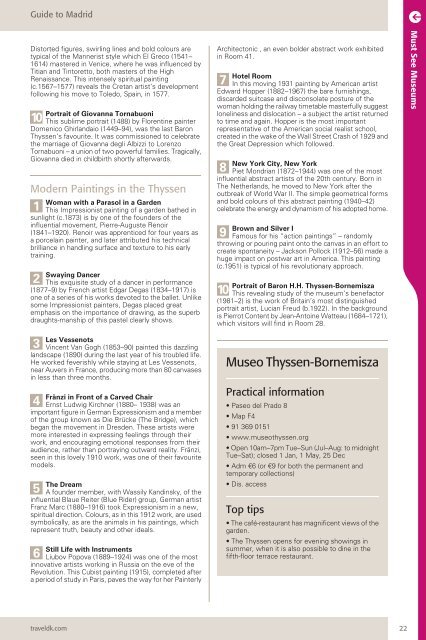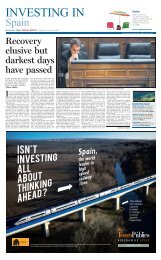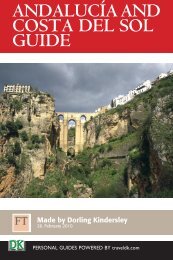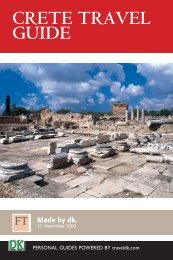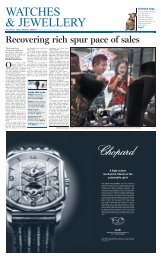Create successful ePaper yourself
Turn your PDF publications into a flip-book with our unique Google optimized e-Paper software.
Guide to Madrid<br />
Distorted figures, swirling lines and bold colours are<br />
typical of the Mannerist style which El Greco (1541–<br />
1614) mastered in Venice, where he was influenced by<br />
Titian and Tintoretto, both masters of the High<br />
Renaissance. This intensely spiritual painting<br />
(c.1567–1577) reveals the Cretan artist’s development<br />
following his move to Toledo, Spain, in 1577.<br />
10<br />
Portrait of Giovanna Tornabuoni<br />
This sublime portrait (1488) by Florentine painter<br />
Domenico Ghirlandaio (1449–94), was the last Baron<br />
Thyssen’s favourite. It was commissioned to celebrate<br />
the marriage of Giovanna degli Albizzi to Lorenzo<br />
Tornabuoni – a union of two powerful families. Tragically,<br />
Giovanna died in childbirth shortly afterwards.<br />
Modern Paintings in the Thyssen<br />
1<br />
Woman with a Parasol in a Garden<br />
This Impressionist painting of a garden bathed in<br />
sunlight (c.1873) is by one of the founders of the<br />
influential movement, Pierre-Auguste Renoir<br />
(1841–1920). Renoir was apprenticed for four years as<br />
a porcelain painter, and later attributed his technical<br />
brilliance in handling surface and texture to his early<br />
training.<br />
2<br />
Swaying Dancer<br />
This exquisite study of a dancer in performance<br />
(1877–9) by French artist Edgar Degas (1834–1917) is<br />
one of a series of his works devoted to the ballet. Unlike<br />
some Impressionist painters, Degas placed great<br />
emphasis on the importance of drawing, as the superb<br />
draughts-manship of this pastel clearly shows.<br />
3<br />
Les Vessenots<br />
Vincent Van Gogh (1853–90) painted this dazzling<br />
landscape (1890) during the last year of his troubled life.<br />
He worked feverishly while staying at Les Vessenots,<br />
near Auvers in France, producing more than 80 canvases<br />
in less than three months.<br />
4<br />
Fränzi in Front of a Carved Chair<br />
Ernst Ludwig Kirchner (1880– 1938) was an<br />
important figure in German Expressionism and a member<br />
of the group known as Die Brücke (The Bridge), which<br />
began the movement in Dresden. These artists were<br />
more interested in expressing feelings through their<br />
work, and encouraging emotional responses from their<br />
audience, rather than portraying outward reality. Fränzi,<br />
seen in this lovely 1910 work, was one of their favourite<br />
models.<br />
5<br />
The Dream<br />
A founder member, with Wassily Kandinsky, of the<br />
influential Blaue Reiter (Blue Rider) group, German artist<br />
Franz Marc (1880–1916) took Expressionism in a new,<br />
spiritual direction. Colours, as in this 1912 work, are used<br />
symbolically, as are the animals in his paintings, which<br />
represent truth, beauty and other ideals.<br />
6<br />
Still Life with Instruments<br />
Liubov Popova (1889–1924) was one of the most<br />
innovative artists working in Russia on the eve of the<br />
Revolution. This Cubist painting (1915), completed after<br />
a period of study in Paris, paves the way for her Painterly<br />
traveldk.com<br />
Architectonic , an even bolder abstract work exhibited<br />
in Room 41.<br />
7<br />
Hotel Room<br />
In this moving 1931 painting by American artist<br />
Edward Hopper (1882–1967) the bare furnishings,<br />
discarded suitcase and disconsolate posture of the<br />
woman holding the railway timetable masterfully suggest<br />
loneliness and dislocation – a subject the artist returned<br />
to time and again. Hopper is the most important<br />
representative of the American social realist school,<br />
created in the wake of the Wall Street Crash of 1929 and<br />
the Great Depression which followed.<br />
8<br />
New York City, New York<br />
Piet Mondrian (1872–1944) was one of the most<br />
influential abstract artists of the 20th century. Born in<br />
The Netherlands, he moved to New York after the<br />
outbreak of World War II. The simple geometrical forms<br />
and bold colours of this abstract painting (1940–42)<br />
celebrate the energy and dynamism of his adopted home.<br />
9<br />
Brown and Silver I<br />
Famous for his “action paintings” – randomly<br />
throwing or pouring paint onto the canvas in an effort to<br />
create spontaneity – Jackson Pollock (1912–56) made a<br />
huge impact on postwar art in America. This painting<br />
(c.1951) is typical of his revolutionary approach.<br />
10<br />
Portrait of Baron H.H. Thyssen-Bornemisza<br />
This revealing study of the museum’s benefactor<br />
(1981–2) is the work of Britain’s most distinguished<br />
portrait artist, Lucian Freud (b.1922). In the background<br />
is Pierrot Content by Jean-Antoine Watteau (1684–1721),<br />
which visitors will find in Room 28.<br />
Museo Thyssen-Bornemisza<br />
Practical information<br />
• Paseo del Prado 8<br />
• Map F4<br />
• 91 369 0151<br />
• www.museothyssen.org<br />
• Open 10am–7pm Tue–Sun (Jul–Aug: to midnight<br />
Tue–Sat); closed 1 Jan, 1 May, 25 Dec<br />
• Adm €6 (or €9 for both the permanent and<br />
temporary collections)<br />
• Dis. access<br />
Top tips<br />
• The café-restaurant has magnificent views of the<br />
garden.<br />
• The Thyssen opens for evening showings in<br />
summer, when it is also possible to dine in the<br />
fifth-floor terrace restaurant.<br />
22<br />
Must See Museums


